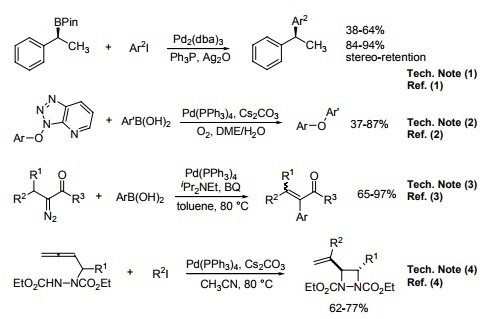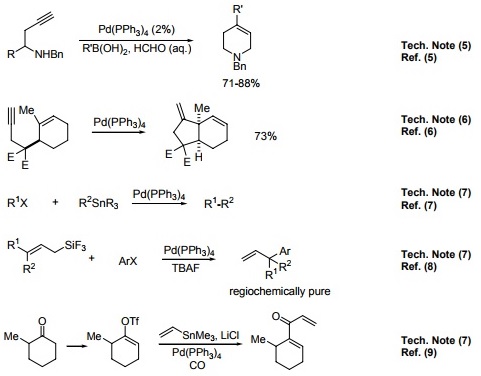Home >> Product >> Noble metals >> Tetrakis(triphenylphosphine)pa ...
- Product Name: Tetrakis(triphenylphosphine)palladium
- Synonyms: (beta-4)-palladiu;Tetrakis(triphenylphosphine)palladiu;TETRAKIS(TRIPHENYLPHOSPHNE) PALLADIUM (0);Tetra(triphenylphosphine) palladium
- CAS No.: 14221-01-3
- Molecular Formula: C72H60P4Pd
- Molecular Weight : 1155.561844
- Specification : 98%
- Place of Origin: China
- Appearance :
- Document : Download
Description of Tetrakis(triphenylphosphine)palladium
| Tetrakis(triphenylphosphine)palladium Chemical Properties | |
| Melting point | 103-107 °C |
| storage temp. | 2-8°C |
| form | Fine Powder or Platelets |
| color | Bright yellow to khaki |
| Water Solubility | insoluble |
| Sensitive | Light Sensitive/Air Sensitive |
| BRN | 6704828 |
| InChIKey | NANALCPCPBPJAB-UHFFFAOYSA-N |
| CAS DataBase Reference | 14221-01-3(CAS DataBase Reference) |
| EPA Substance Registry System | Palladium, tetrakis(triphenylphosphine)-, (T-4)-(14221-01-3) |
| Safety Information | |
| Hazard Codes | Xi,Xn |
| Risk Statements | 20/22-40-36/37/38 |
| Safety Statements | 22-24/25-36/37-37/39-26 |
| WGK Germany | 3 |
| F | 8-10-23 |
| Hazard Note | Air sensitive/Light sensitive/Irritant |
| TSCA | No |
| HazardClass | MOISTURE SENSITIVE, STORED UNDER ARGON |
| HS Code | 28439090 |
| Tetrakis(triphenylphosphine)palladium Usage And Synthesis | |
| Chemical Properties | yellow crystals |
| Uses | suzuki reaction |
| Uses | Tetrakis(triphenylphosphine)palladium(0) is widely used as a catalyst for palladium-catalyzed coupling reactions. |
| Uses | Pd(PPh3)4 is widely used as a catalyst for palladium-catalyzed coupling reactions. Prominent applications include the Heck reaction, Suzuki coupling, Stille coupling, Sonogashira coupling, and Negishi coupling. |
| Uses | A high-yielding catalyst used in coupling reactions. |
| Reactions |
|
| Purification Methods | The palladium complex is recrystallised from EtOH. It should not be heated excessively as it dissociates to Pd(PPh3)3 and PdPh3 and then further to Pd(PPh3)2 and PPh3. It is also air sensitive as PPh3 is oxidized to PPh3O. It is stable only for short periods because on exposure to heat or air it turns from yellow to orange and dissociates in solution so the solutions should be used directly. However it can always be prepared freshly by mixing Pd(NO3)2 (2mmols) and PPh3(2mmols) in hot *C6H6 when vigorous evolution of nitric oxide occurs and a solid mass separates. This is collected and crystallised from EtOH. Its cryoscopic constant in *C6H6 (at 0.601g/20mL) corresponds to M 1156 [Malatesta & Angoletti J Chem Soc 1186 1957]. It is a useful catalyst for Suzuki coupling reactions [Trost Tetrahedron 33 2615 1977]. [Beilstein 16 IV 954.] This palladium catalyst bound to a polymer support (~0.06mmol/g) is also commercially available [cf Fenger & LeDrain Tetrahedron Lett 39 4287 1998]. [Beilstein 16 IV 954.] |
| Tetrakis(triphenylphosphine)palladium Preparation Products And Raw materials | |
| Preparation Products | 4-PHENYLETHYNYLPHTHALIC ANHYDRIDE-->PLUMBAGIN-->3-AMINOBIPHENYL-->Dimidium bromide-->4-(6-FORMYLPYRIDIN-2-YL)BENZONITRILE-->6-(2-THIENYL)-2-PYRIDINECARBOXALDEHYDE-->6-(THIOPHEN-3-YL)PYRIDINE-2-CARBALDEHYDE-->2-CHLORO-7H-PYRROLO[2,3-D]PYRIMIDINE-->1-(3-AMINO-PYRIDIN-2-YL)-ETHANONE-->3-(6-FORMYL-PYRIDIN-2-YL)-BENZONITRILE-->4-BENZYLOXY-3-INDOLEACETONITRILE-->3-(4-METHYLPHENYL)BENZALDEHYDE-->3-(3-PYRIDINYL)BENZOIC ACID-->6-(3-NITROPHENYL)-2-PYRIDINECARBOXALDEHYDE-->6-(4-METHYLSULFANYLPHENYL)PYRIDINE-2-CARBALDEHYDE-->4-Hex-1-ynylbenzaldehyde-->6-(4-CHLOROPHENYL)PYRIDINE-2-CARBALDEHYDE-->6-(4-FLUOROPHENYL)PYRIDINE-2-CARBALDEHYDE-->6-(4-METHOXYPHENYL)PYRIDINE-2-CARBALDEHYDE-->3-AMINO-6-PHENYLPYRIDAZINE |
| Raw materials | Etanol-->Ethyl acetate-->Diethyl ether-->Toluene-->Acetonitrile-->Hydrazinium hydroxide-->Dimethyl sulfoxide-->Hydrazine hydrate-->Triphenylphosphine-->tert-Butyl methyl ether-->Palladium chloride |
Please leave your message to us :
( Your Information is an important part of our business,and we will not share or sell any of it to anyone.)
Products
Contact Us
- Email: info@vosunbio.com
- Tel:+86-512-66566131,89888618
- sales extension 8002



